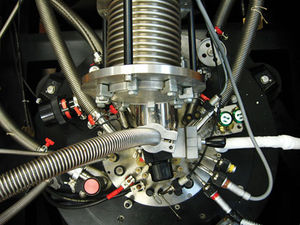Superinsulators: Difference between revisions
No edit summary |
No edit summary |
||
| Line 7: | Line 7: | ||
The superinsulating state was first observed on 7 April 2008 by American scientist Valerii Vinokur and Russian scientist Tatyana Baturina at Department of Energy's Argonne National Laboratory in collaboration with several European institutions. It occurred in a titanium nitride film. | The superinsulating state was first observed on 7 April 2008 by American scientist Valerii Vinokur and Russian scientist Tatyana Baturina at Department of Energy's Argonne National Laboratory in collaboration with several European institutions. It occurred in a titanium nitride film. | ||
This discovery opens new directions of inquiry in condensed matter physics and breaks ground for a new generation of microelectronics. | This discovery opens new directions of inquiry in condensed matter physics and breaks ground for a new generation of microelectronics. | ||
See the article in the March 2010 IEEE Spectrum Magazine, page 11.<br>http://spectrum.ieee.org/semiconductors/materials/scientists-solve-mystery-of-superinsulators | See the article in the March 2010 IEEE Spectrum Magazine, page 11.<br>http://spectrum.ieee.org/semiconductors/materials/scientists-solve-mystery-of-superinsulators | ||
Revision as of 21:22, 27 January 2011
Superinsulators
A superinsulator is a material that at low temperatures (and possible combinations of other conditions) has a near infinite resistance. The superinsulating state has many parallels to the superconducting state, and can be destroyed (in a sudden phase transition) by increased temperature, magnetic fields and voltage.
The superinsulating state was first observed on 7 April 2008 by American scientist Valerii Vinokur and Russian scientist Tatyana Baturina at Department of Energy's Argonne National Laboratory in collaboration with several European institutions. It occurred in a titanium nitride film.
This discovery opens new directions of inquiry in condensed matter physics and breaks ground for a new generation of microelectronics.
See the article in the March 2010 IEEE Spectrum Magazine, page 11.
http://spectrum.ieee.org/semiconductors/materials/scientists-solve-mystery-of-superinsulators
The IEEE has a Society closely aligned here.
